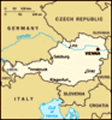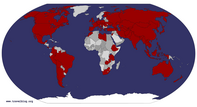Advertisement
Published: October 26th 2017
How many times have you been to the opera in Vienna? How many times have you had a Viennese coffee? How many times have you listened to Strauss and Haydn? For me, I am not sure of any count. Vienna is a mystery to me, perhaps back in the Seventies? The German name for Vienna is Wien, that means Austria's most famous dish, wiener schnitzel, translates to Viennese schnitzel.
Fast forward to today, on the train from Budapest to the capital city of Vienna. This city of 1.7 million people actually produces wine within its city limits, to the tune of 1700 acres and 340 vintners. And can you believe four of the top ten classical composers in history worked in Vienna from 1750 to 1825? Better yet, Sigmund Freud lived and worked in Vienna for most of his famous career. Who among us has not read about Freud in college, or taken a psychology class at one time or another?
The famous French pastry, the croissant, originated here in Vienna as the Austrian kipferl. Bakers in Vienna made kipferl to commemorate Austria’s victory over the Ottoman Turks in 1683, their shape based on the
crescents seen on the uniform of the enemy. Credit Marie Antoinette for introducing the kipferl to France.
Did you know that Pez was invented here back in 1927, the same year Babe Ruth hit 60 homeruns! The name Pez is an abbreviation on the German word “pfefferminz”, meaning peppermint. Because the original PEZ candies only came in that one flavor! The dispenser was invented in 1949, designed to look like a lighter. Smoking was prohibited at that time, so the Pez slogan was “No Smoking – PEZing Allowed.” I hope they have a Pez Museum!
The snow globe was also invented in Vienna. In 1900, Erwin Perzy, a fine instruments mechanic, was trying to improve the brightness of lightbulbs for a surgical lamp. But instead, he accidentally invented a snow globe. The sewing machine was also invented here.
Like Berlin, Vienna was also divided into four parts after WWII, and occupied by the United States, France, the United Kingdom and the Soviet Union. The first district of Vienna, the inner city, was administered by all 4 powers. The occupation, and division, of Vienna ended in 1955 with the Austrian State Treaty.
So, are you excited about Vienna yet? Less
interesting, Vienna has been home to OPEC since 1965. Almost 3 million people a year visit St. Stephen's Cathedral, built in the 12th century. But too bad Mr. Mike left for home. Coffee is about more than just caffeination for Austrians—it’s part of their heritage. In fact, in 2011, Viennese coffee houses, which originated in the 17th century, were put on UNESCO’s Intangible Cultural Heritage list, as they are a place “where time and space are consumed, but only the coffee is found on the bill.”
The real-life
Maria von Trapp, made famous by
The Sound of Music, was actually born in Vienna on January 26, 1905. Speaking of the dearly departed, The Zentralfriedhof, the “Central Cemetery” of Vienna, opened in 1874, holds a dead population of almost twice the living population of Vienna. Ordering a hot dog here is critical. At any one of Vienna’s trademark hot dog stands, get ready to answer whether you prefer the sweet
kremser mustard or spicy
estragon. Vendors may shorten it to
süss (sweet) or
scharf (spicy). With the dog and the schnitzel, no wonder over half of Austrian men are overweight!
How many times have you been to the opera in Vienna? How many
times have you had a Viennese coffee? How many times have you listened to Strauss and Haydn? For me, I am not sure of any count. Vienna is a mystery to me, perhaps back in the Seventies? The German name for Vienna is Wien, that means Austria's most famous dish, wiener schnitzel, translates to Viennese schnitzel.
Fast forward to today, on the train from Budapest to the capital city of Vienna. This city of 1.7 million people actually produces wine within its city limits, to the tune of 1700 acres and 340 vintners. And can you believe four of the top ten classical composers in history worked in Vienna from 1750 to 1825? Better yet, Sigmund Freud lived and worked in Vienna for most of his famous career. Who among us has not read about Freud in college, or taken a psychology class at one time or another?
The famous French pastry, the croissant, originated here in Vienna as the Austrian kipferl. Bakers in Vienna made kipferl to commemorate Austria’s victory over the Ottoman Turks in 1683, their shape based on the crescents seen on the uniform of the enemy. Credit Marie Antoinette for
introducing the kipferl to France.
Did you know that Pez was invented here back in 1927, the same year Babe Ruth hit 60 homeruns! The name Pez is an abbreviation on the German word “pfefferminz”, meaning peppermint. Because the original PEZ candies only came in that one flavor! The dispenser was invented in 1949, designed to look like a lighter. Smoking was prohibited at that time, so the Pez slogan was “No Smoking – PEZing Allowed.” I hope they have a Pez Museum!
The snow globe was also invented in Vienna. In 1900, Erwin Perzy, a fine instruments mechanic, was trying to improve the brightness of lightbulbs for a surgical lamp. But instead, he accidentally invented a snow globe. The sewing machine was also invented here.
Like Berlin, Vienna was also divided into four parts after WWII, and occupied by the United States, France, the United Kingdom and the Soviet Union. The first district of Vienna, the inner city, was administered by all 4 powers. The occupation, and division, of Vienna ended in 1955 with the Austrian State Treaty.
So, are you excited about Vienna yet? Less interesting, Vienna has been home to OPEC since 1965. Almost 3 million people a year visit St. Stephen's Cathedral, built in the 12th century. But too bad Mr. Mike left for home. Coffee is about more than just caffeination for Austrians—it’s part of their heritage. In fact, in 2011, Viennese coffee houses, which originated in the 17th century, were put on UNESCO’s Intangible Cultural Heritage list, as they are a place “where time and space are consumed, but only the coffee is found on the bill.”
The real-life
Maria von Trapp, made famous by
The Sound of Music, was actually born in Vienna on January 26, 1905. Speaking of the dearly departed, The Zentralfriedhof, the “Central Cemetery” of Vienna, opened in 1874, holds a dead population of almost twice the living population of Vienna. Ordering a hot dog here is critical. At any one of Vienna’s trademark hot dog stands, get ready to answer whether you prefer the sweet
kremser mustard or spicy
estragon. Vendors may shorten it to
süss (sweet) or
scharf (spicy). With the dog and the schnitzel, no wonder over half of Austrian men are overweight! This is surprising: Vienna is sometimes known synonymously with the Baroque and Rococo styles. The city also has a rich Romanesque

history and old Roman ruins beneath the modern city level. Interestingly enough, Vienna is greatly lacking in any Renaissance architecture. Because of two large Turkish sieges upon the city during the height of Renaissance influence, barely any architecture of this time was built. Instead, the overwhelmingly beautiful and decorative Baroque style dominates the city, leaving other architectural styles to stand out among the rest! Over 200 balls take place every year in Vienna. Balls are offered usually for 3 months starting in January and lasting through March. The most popular venue for a Viennese ball is at the Hofburg Imperial Palace in the center of the city. Live orchestras play the classical music, waltzes, and even some 20th century pieces providing a taste of different dance for everyone. However, everyone in Vienna seems to know how to waltz, and rather well. I took ballroom dance lessons in the 8th grade. Did you?
Good news for Lexi: The Viennese are famous for their love of dogs and they take their four-legged friends just about everywhere. Dogs are welcome on public transportation (without a carrier!) and in many boutiques and restaurants.
My email would not be complete without a list of some famous Viennese: The musicians seem to dominate, along with Sigmund Freud. The list of classical musicians is impressive: Beethoven, Mozart, Strauss, Schubert, Brahms, Haydn, and Mahler, whose music I cannot tolerate. Other famous people: Gustav Klimt, Gregor Mendel, Hedy Lamarr, Karl Menger, Hans Asberger, Peter Drucker, Maria Theresa, the von Trapp family, Arnold Governator, and Johann von Goethe,
Vienna's best known market is the Naschmarkt, with about 120 vendors. Besides wining, dining and shopping, it is a great place to meet. ON Market here is open 24 hours, and offers up some innovative Asian cuisine. Saturday, when I visited, is the best, since they also have a flea market that day.
So, as you can read, Vienna is quite the place. Why can't I remember it with any clarity? Fully a quarter of the population of Austria lives here. I have so much to do, and so little time. Maybe I can refresh my memory as I stroll the city?
This is surprising: Vienna is sometimes known synonymously with the Baroque and Rococo styles. The city also has a rich Romanesque

history and old Roman ruins beneath the modern city level. Interestingly enough, Vienna is greatly lacking in any Renaissance architecture. Because of two large Turkish sieges upon the city during the height of Renaissance influence, barely any architecture of this time was built. Instead, the overwhelmingly beautiful and decorative Baroque style dominates the city, leaving other architectural styles to stand out among the rest! Over 200 balls take place every year in Vienna. Balls are offered usually for 3 months starting in January and lasting through March. The most popular venue for a Viennese ball is at the Hofburg Imperial Palace in the center of the city. Live orchestras play the classical music, waltzes, and even some 20th century pieces providing a taste of different dance for everyone. However, everyone in Vienna seems to know how to waltz, and rather well. I took ballroom dance lessons in the 8th grade. Did you?
Good news for Lexi: The Viennese are famous for their love of dogs and they take their four-legged friends just about everywhere. Dogs are welcome on public transportation (without a carrier!) and in many boutiques and restaurants.
My email would not be complete without a list of some famous Viennese: The musicians seem to dominate, along with Sigmund Freud. The list of classical musicians is impressive: Beethoven, Mozart, Strauss, Schubert, Brahms, Haydn, and Mahler, whose music I cannot tolerate. Other famous people: Gustav Klimt, Gregor Mendel, Hedy Lamarr, Karl Menger, Hans Asberger, Peter Drucker, Maria Theresa, the von Trapp family, Arnold Governator, and Johann von Goethe,
Vienna's best known market is the Naschmarkt, with about 120 vendors. Besides wining, dining and shopping, it is a great place to meet. ON Market here is open 24 hours, and offers up some innovative Asian cuisine. Saturday, when I visited, is the best, since they also have a flea market that day.
So, as you can read, Vienna is quite the place. Why can't I remember it with any clarity? Fully a quarter of the population of Austria lives here. I have so much to do, and so little time. Maybe I can refresh my memory as I stroll the city?
Advertisement
Tot: 0.13s; Tpl: 0.016s; cc: 13; qc: 27; dbt: 0.054s; 1; m:domysql w:travelblog (10.17.0.13); sld: 1;
; mem: 1.2mb









































